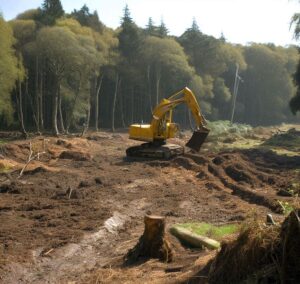Ancient Woodlands, aptly named so due to their old age, are distinguished by their unique, undisturbed habitats and rich biodiversity. Yet, like many natural areas, these woodland ecosystems are under threat from various factors such as deforestation and climate change. The diverse flora and fauna that call these woodlands home are experiencing unprecedented shifts in their natural habitats, making the active restoration of these woodlands a pressing concern.
Detailed Examination of Ancient Woodlands
Maintaining a rich biodiversity, Ancient Woodlands harbor a remarkable number of plant and animal species, some of which are found nowhere else. These woodlands serve as sanctuaries for native fauna and uniquely adapted flora, thereby playing an indispensable role in conserving local biodiversity. They are also genetic storehouses, preserving vital, irreplaceable strands of evolution that can offer significant insights into the survival and sustainability of various species in a changing world.

Historically speaking, the Ancient Woodlands are living museums showcasing pre-industrial life and societal progression. Each tree, with its intricate growth rings, holds a record of environmental conditions that extends back centuries. The landscape character and layout of these forests allow us a glimpse into ancient land use systems and human interaction with the environment. The traditions and practices associated with these woodlands further mirror cultural values and historical narratives that enrich our understanding of the past.
Economically, Ancient Woodlands generate substantial wealth through a range of resources. Timber derived from ancient trees is highly sought after for its exceptional quality, strength, and durability. Moreover, non-timber forest products like mushrooms, berries, nuts, and medicinal plants from these forests contribute to local economies significantly.
On the recreational front, these ancient forests offer unique nature-based experiences. Walking or hiking through Ancient Woodlands is a serene, spellbinding journey that attracts both local residents and tourists. These activities support local tourism and associated businesses, thereby impacting the local economy positively. In addition, the aesthetic and tranquility of these woodlands have therapeutic qualities, contributing to the emotional and mental well-being of visitors.
The ecological, historical, and economic values of Ancient Woodlands are truly wide-ranging and immense. It is therefore critical that we afford these essential habitats the protection and conservation they undoubtedly deserve.
While Ancient Woodlands have been resilient habitats for centuries, they are being threatened by a slew of modern problems. Deforestation, climate change, and the spreading of invasive species are some of the most pressing issues. Climate change, in particular, poses a severe risk as it alters temperature and precipitation patterns, causing a domino effect in ecosystems. Changes in these woodlands have started to occur, and the results are alarming: decreased biodiversity, loss of habitat, and the extinction of species.
Insight into Active Restoration
Active restoration is a relatively new and promising approach to conservation that includes practices aimed at restoring the structure and function of ecosystems. Active restoration enhances the resilience of forests against numerous environmental stressors. It also protects endangered species by restoring their natural habitats. In Ancient Woodlands, active restoration could be the key to reviving their rich biodiversity and reversing the damages caused by various stressors.
Around the world, active restoration has been proven to make a notable difference. In Brazil’s Amazon Rainforest, areas that underwent active restoration saw a significant return of native tree species within a few years. Similar results were noted on rejuvenated woodland sites in the UK, where the removal of invasive species encouraged the growth of native plants, improving overall woodland health.
Active restoration strategies implemented can include the removal of invasive species, the reintroduction of native species, and the promotion of natural regeneration. Additionally, local communities play a vital role in restoring these ecosystems. Their active participation increases the success rate of restoration efforts and fosters a sense of stewardship over the land.
The Future of Ancient Woodlands and Active Restoration
As we continue to grapple with environmental crises like habitat loss, biodiversity decline, and climate change, active restoration and through it, the conservation of Ancient Woodlands, emerges as an integral part of the solution. The heightened biodiversity resulting from active restoration within these woodlands not only ensures the survival of myriad species but also bolsters the ecosystem’s resilience.

One of the remarkable benefits projected from restored Ancient Woodlands is their increased capacity for carbon sequestration. Forests, especially older and more diverse ones, are among the world’s vital carbon sinks—natural systems that absorb and store carbon dioxide from the atmosphere. Enhancing the health and variety of these ancient ecosystems can augment their ability to sequester carbon, thus playing a vital role in fighting climate change.
The active restoration of Ancient Woodlands yields returns far beyond environmental profits; it safeguards cultural and historical riches as well. These woodlands encapsulate centuries of human and natural history, traditions, and knowledge, making them invaluable assets to our cultural heritage. By restoring these landscapes, we are preserving lessons, stories, and connections to our past that further our understanding of human development and our relationship with nature.
Despite the daunting challenges that lie in the path of Ancient Woodland restoration, a collective resolve can turn the tide in favor of these endangered habitats. This restoration requires research, resources, policy support, and above all, public commitment to adapting sustainable practices. By fostering a sense of shared responsibility towards these landmarks of nature and history, we can pave the way for effective local and global restoration strategies.
Promoting the awareness and understanding of Ancient Woodlands and the importance of their conservation can inspire further commitment and action. Educational campaigns, community involvement programs, and partnerships with local and international environmental organizations are some of the potential transformative steps towards achieving a wider societal engagement.
The future of Ancient Woodlands under active restoration holds potential for both ecological revival and preserving humankind’s natural heritage. By taking aggressive action today, we ensure that these trees continue to stand tall, serving as rich reservoirs of biodiversity and living testaments to our history.